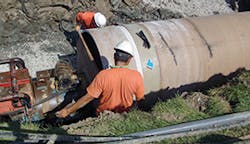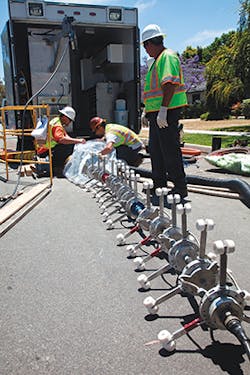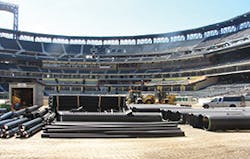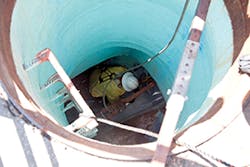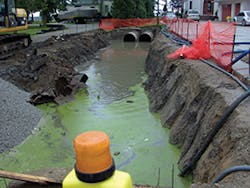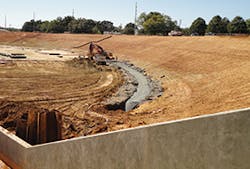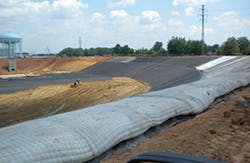Piping systems have existed for millennia; ancient Crete made its from terra cotta, a material that’s still used today. When the Romans discovered how to refine lead, the element was employed in piping systems. (The word plumber derives from the Latin term for lead: plumbum.) Later, manufacturing discoveries added iron, steel, and concrete to plumbing’s repertoire; when high density polyethylene plastic (HDPE) was developed in 1951, it, too, found work in the piping industry.
Creating an Underdrain System
When the North Carolina’s Charlotte-Mecklenburg Utilities needed to combine two existing reservoirs built in the early 20th century, it realized the new liner for the resultant 250-million-gallon-capacity reservoir would need a safety system to protect from possible leakage and upward pressure caused by groundwater. Hazen and Sawyer P.C., an engineering firm in Raleigh, NC, was hired to develop the system, and HDPE piping was seen as the solution. A grid of 6-, 8-, 12-, and 18-inch-diameter perforated pipes collects water seepage to reduce pressure underneath the liner. Nearly 15,000 linear feet of pipe was used for the system, which sits under 35 feet of water and 4 feet of fill.
“The goal of the pipe is to protect the liner,” explains George Eller, P.E., Hazen and Sawyer’s design engineer. “The pipe will catch any water coming to the bottom of the liner, including leakage and groundwater, and reduce the upward pressure on the liner that excess water would exert. The pipe system will prevent the liner from floating. It basically operates like a French drain.
“The piping is there because of the membrane system,” he continues, “which was there for two purposes: to reduce water losses from the reservoir, and to avoid its contamination. There are three known sites of contaminated groundwater across the street–a couple of gas stations and a printing operation–so Charlotte-Mecklenburg Utilities was interested in making a barrier between the drinking water supply and the potentially contaminated groundwater. However, there isn’t any contaminated groundwater on the site; we monitor it.”
Light train preparation
The reservoir is lined with a 30-ml polymer membrane.
“That’s not as thick as a municipal solid waste landfill membrane, but fairly thick,” says Eller. “There’s two feet of soil atop that, as a secondary liner, and also as a counterweight, to hold the membrane down.”
Below the membrane, Thalle Construction Company Inc. of Hillsborough, NC, installed the underdrain system of perforated HDPE corrugated plastic pipe (CPP).
“The pipes are dual-walled, six to 18 inches in diameter,” he says. “Piping was placed underneath the membrane, to prevent uplift from the groundwater. When the reservoir is full, the water pressure atop the membrane would keep it in place. However, when the reservoir is emptied, groundwater pressure underneath, and none above, could cause uplift of the membrane, damaging it.”
Has the reservoir been emptied due to the recurring droughts of the past few years?
“No, but the utility sometimes pulls the reservoir down, to do maintenance,” answers Eller. “There’s maybe a two-day water supply in the reservoir; the main reservoir is a lake several miles away. The site is temporary storage; it also allows additional sedimentation, and allows the water to be oxygenated.”
Below the turf, more than 2 miles of piping drain and aerate the field.
Why use corrugated pipe?
“Corrugation makes the pipe with less material, but more strength,” he says. “Only the outside is corrugated; the pipe’s interior wall is smooth. The piping system was laid in trenches, with geocomposite drainage material under the membrane, which brings water to the pipes. The pipes then collect any leakage through the liner. Where the underdrain system pipes come to a central point, there are two solid HDPE pipes. This area is filled with cement and bentonite grout, which further stops seepage.
“For underdrainage, plastic perforated pipe is the only choice any more,” concludes Eller. “You’d once get perforated clay or PVC pipe, but it’s labor intensive to get those materials perforated; it’s much easier to perforate HDPE. HDPE pipes are economical; they don’t corrode, and as long as they’re not in sunlight they can last indefinitely.”
More Than Drainage
Built for the New York Mets, CitiField is sited on reclaimed marshland at Willets Point, just south of LaGuardia Airport. The stadium was erected on piles embedded into bedrock; however, the playing field was designed to be independent of the stadium, to accommodate any future settling.
“Because the stadium is on a former swamp, the playing field is like a “˜bowl’ made of three feet of lightweight concrete fill. If it would settle, it would do so at the same rate. The playing field is like a big cork in the middle of the stadium,” explains John Sulinski, vice president of operations for Amityville, NY’s LandTek Group, which constructed the field.
Using corrugated HDPE pipe from Columbus, OH’s Advanced Drainage Systems Inc. (ADS), Sulinski’s firm created an underground piping system shaped like a tree. A 30-inch-diameter pipe runs under the field, from behind home plate to the warning track. This 430-foot run of ADS N-12 WT pipe has watertight bell and spigot connections between sections. Connected to this trunk line are 6-inch-diameter lateral branches, 42 lines on each side, 10 feet apart. The HDPE pipe is perforated on the top to allow water to infiltrate and will also provide a means for air exchange in the turf. The project used 560 feet of 30-inch-diameter and 11,600 feet of 6-inch-diameter perforated pipe and 240 feet of 6-inch solid-wall HDPE pipe from ADS.
Drainage, of course, is the main purpose of this piping system, and it has benefits for the baseball team as well; faster drainage means the Mets and their opponents can play much earlier after a rain. Draining away excess water also stops the natural turf from suffering rot damage. But just as the pipes can draw water away from the field, it can also take water and air to the field when needed.
“The piping system’s goal was twofold,” explains Sulinski. “First, to effectively drain the field; second, to aid in the growth and integrity of the natural grass turf. A large heater connected to the system allows groundskeepers to circulate warm air up through the root system of the grass. This three- to four-degree boost actually can help green the turf and is a key part of starting the grass growing in the Northeast’s sometimes uncertain early springs.”
A playable field, glorious grass—all made possible by pipe
Drainage is accomplished quickly by creating a vacuum in the pipes; water is then sent to New York’s stormwater system. Just as heat can be sent through the pipes, by connecting a SubAir unit to the manhole and drainage system, cool air can be circulated on steamy summer days, to give the grass roots some respite.
“Groundskeepers like the system,” says Sulinski. “With the costs of maintaining a live playing field, this technology is catching on, although it’s expensive.”
Building sports facilities is LandTek Group’s bread and butter.
“It’s fun,” says Sulinski. “It’s nice to get a value from building something. When I watch sports, I look at where they’re playing, and sometimes lose track of the score,” he chuckles. “We do a lot of synthetic grass installations as well, and use the ADS piping for those, because such fields can take on a lot of water. We use a lot of ADS products; almost every week we get direct shipments of its products. ADS has a tremendous amount of pipe and fittings.”
Remediating Aging Storm Drains
Clinton Township, MI, had a problem. “This is a case where corrugated metal storm drains that were installed in the mid-1940s rotted away, blocking the flow of stormwater and causing severe underground soil erosion,” says Macomb County public works commissioner Anthony Marrocco.
Eventually this erosion created a 20-foot by 10-foot sinkhole, and the Cottrell Creek Drain collapsed. Repairs had to be made, and quickly, as the aged drain accepted over 300 acres of drainage from Clinton Township and surrounding areas. Funds were tight; the Macomb County Drain Commission chose to slipline the collapsed line to prevent further damage, and selected Houston, TX’s Hobas Pipe USA as supplier.
General contractor Tyger Excavating Inc. of New Haven, MI, was hired to perform the remediation work and repairs to the aging infrastructure. Tyger started work on the line in September 2009, repairing the deteriorated pipe by sliplining with Hobas centrifugally cast, fiberglass-reinforced, polymer mortar (CCFRPM) pipe. The 20-foot-long sections of 54-inch-diameter, 65-psi-stiffness class pipe were inserted into an existing 60-inch corrugated metal pipe. The new pipes were manufactured with a flush bell spigot to ease installation into the deteriorated line. The liner pipe was installed in two runs of 250 linear feet each, and utilized open-cut installation methods for the 10-foot-deep area where the 20-foot by 10-foot sinkhole originally appeared.
“We had never used CCFRPM before,” says Tyger’s Jeff Peyerk. “After we learned about it, we thought it was a more durable option for this installation than the proposed profile wall PVC product.”
Liner installation
Some Cottrell Creek Drain segments were too damaged to reline; for those areas, the pipe was direct-buried. The project had more than its share of challenges; in certain areas, the pipe had to be jacked into place–being pushed through the existing pipe that was filled with soil. Once the CCFRPM was in place, the material within the pipe was excavated.
“We expected to have more challenges than we actually had,” says Peyerk. “The combination of the strength of the CCFRPM pipe, and the ability to push with our bore machine made for an easier job than we anticipated. We would definitely recommend this product for future projects. The delivery was quick and on time as promised.”
In addition, using trenchless technology caused less disruption to the neighborhood, making local residents happier.
A massive sinkhole due to failed drain lines
Change Pipes–No Digging!
As Coronado, CA, is surrounded by San Diego Bay and the Pacific Ocean, its groundwater table is relatively shallow, especially toward the city’s southwest quadrant, where it was relatively common to have standing water in street gutters due to groundwater rising to the surface. The city had installed perforated pipe to collect groundwater, lower its elevation, and reduce the volume of water reaching the surface. The perforated pipe was then connected to an existing storm drain system, and the collected groundwater was pumped to Coronado’s North Beach and flowed into the ocean.
In spring 2011, the state told the city it could no longer discharge into the ocean. “Although the groundwater had been pumped to North Beach for some time, with the quality of the water monitored on a regular basis, the California Regional Water Quality Control Board determined Coronado could no longer pump the groundwater out to the ocean, after water-quality tests yielded higher-than-allowed bacteria levels,” explains Tom Jovanovic, an engineer with the city of Coronado.
“Without the ability to discharge to the ocean, the perforated pipe was allowed to fill with water and remain full,” he explains. “The city had the ability to empty the perforated pipe by pumping the groundwater into an adjacent sewer system; however, this option was costly and taxed the system’s capacity. A cost analysis was performed and showed that lining the perforated pipe would be more cost-effective than traditional dig-and-replace methods. Lining the pipe was also less disruptive to this residential neighborhood. The decision was made to line the perforated pipe.”
Downstream Services Inc. of Escondido, CA, won the job bid, and employed relining technology from Reline America.
The high water table was just the first of many challenges.
“The main challenge was the continuous inflow of water into the perforated pipe–not only through perforations in the pipe itself, but also infiltration in upstream pipes,” says Jovanovic. “The continuous flow of water created a challenging environment for the contractor to work in, necessitated several flow bypass setups, and increased the risk of uncured liners being exposed to water. In addition, several of the pipe segments being lined were 300 to 400 feet in length, and the amount of time it took to insert an uncured liner segment into the existing pipe, and the time it took to inflate and cure a liner, was significant. This fact, combined with the allowed hours of operation for construction crews, meant some segments took two days to fully install and cure the liner.”
“The city’s culverts were approximately 12 feet deep, and the water table was at 11 feet,” says Downstream Services’ vice president, Victor Roberts. “There was quite a bit of strain on the existing pipe because of the water. Coronado needed liners that wouldn’t infiltrate or leak, and ours was the only one they could’ve used, as some pipes were pushing 200 GPM [gallons per minute] into the culvert. In the lining world, going against such pressure makes liners hard to put in–plus, some were 425 feet long. Also, cured-in-place pipe can’t be installed in infiltration areas; HDPE pipe requires underpressure grout, and cement in salt water doesn’t work!”
Surgery was needed.
“Our liners are inserted, then inflated in the pipes–almost like angioplasty,” says Roberts. Reline America’s liners are fabricated from fiberglass and resin. Somewhat soft when inserted, the liners are cured with UV light, which makes them rigid. “This is fairly new tech for the US, although it’s been used for 15 or 20 years in Europe,” says Roberts. “One of its advantages is that when cured, it’s extremely strong. Other relining technologies are thermal-cured. Unfortunately, when temperatures reach 80 degrees, the products can begin curing–giving those products a two-week shelf life. Our liners have a shelf life of about six months, sometimes longer. However, we test anything older, to ensure the product will perform as promised.”
Installing liners in reservoirs provides a safety system, protecting them from possible leakage and upward pressure caused by groundwater.
Isn’t working in the dark impossible?
“We can see inside the pipe because of the camera on the UV light train,” explains Roberts. “As it’s sent through, you can see the liner isn’t twisted; if it is, you can fix it by pulling out the liner and inserting it again. If the light train doesn’t see any problems, operators flip the switch to turn on the UV light, and pull back the light train to cure the pipe.”
Reline America’s liners fit pipes from 5 to 51 inches in diameter, so applications abound–from residential piping to huge water mains. The majority of Coronado’s pipes were 30 and 36 inches in diameter, with a few small segments of 12-inch perforated pipe. In total, Downstream Services relined about 3,000 feet of pipe in 12 segments.
To facilitate the liners’ installation, Coronado applied for, and received, a temporary discharge permit to allow groundwater discharges to the ocean during construction operations. Obtaining the permit required that the groundwater to be routinely tested and to pass stringent biological and chemical tests, including several tests for toxicity, bacteria, and heavy metals. In theory, with the pipe now lined, the only water that enters the storm drain system would be from storm drain inlets during a rain event and this water, in accordance with city permits, can be pumped to North Beach and out to the ocean.
The AOC resin used to make the liner is formulated
to cure when exposed to UV light.
“Unfortunately, groundwater infiltration into upstream pipes still collects within the storm drain system and slowly fills the newly lined perforated pipe,” reports Jovanovic. “As the city plans for additional improvements to reduce infiltration, the storm drain system will be drained into the sewer system or be allowed to fill with water and reach equilibrium with the surrounding groundwater table. Sliplining is a technology the city will consider for future pipe rehabilitation projects on both sewer and storm drain pipes.”
